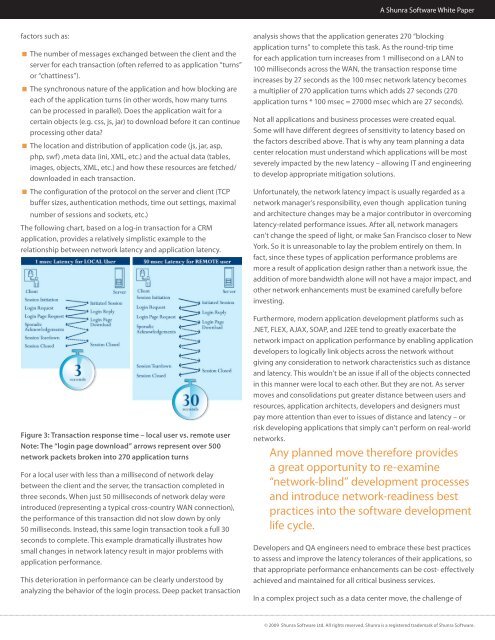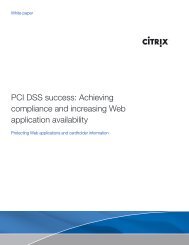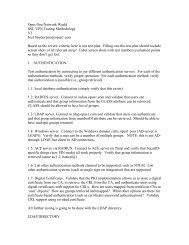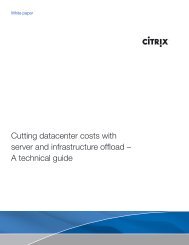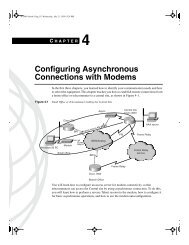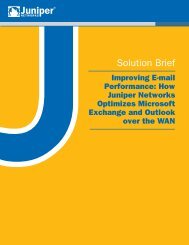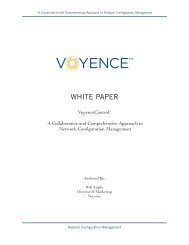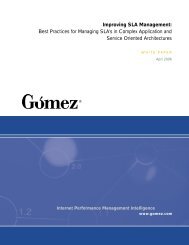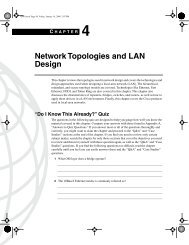The Impact of Data Center and Server Relocation ... - Network World
The Impact of Data Center and Server Relocation ... - Network World
The Impact of Data Center and Server Relocation ... - Network World
Create successful ePaper yourself
Turn your PDF publications into a flip-book with our unique Google optimized e-Paper software.
A Shunra S<strong>of</strong>tware White Paperfactors such as: <strong>The</strong> number <strong>of</strong> messages exchanged between the client <strong>and</strong> theserver for each transaction (<strong>of</strong>ten referred to as application “turns”or “chattiness”). <strong>The</strong> synchronous nature <strong>of</strong> the application <strong>and</strong> how blocking areeach <strong>of</strong> the application turns (in other words, how many turnscan be processed in parallel). Does the application wait for acertain objects (e.g. css, js, jar) to download before it can continueprocessing other data? <strong>The</strong> location <strong>and</strong> distribution <strong>of</strong> application code (js, jar, asp,php, swf) ,meta data (ini, XML, etc.) <strong>and</strong> the actual data (tables,images, objects, XML, etc.) <strong>and</strong> how these resources are fetched/downloaded in each transaction. <strong>The</strong> configuration <strong>of</strong> the protocol on the server <strong>and</strong> client (TCPbuffer sizes, authentication methods, time out settings, maximalnumber <strong>of</strong> sessions <strong>and</strong> sockets, etc.)<strong>The</strong> following chart, based on a log-in transaction for a CRMapplication, provides a relatively simplistic example to therelationship between network latency <strong>and</strong> application latency.Figure 3: Transaction response time – local user vs. remote userNote: <strong>The</strong> “login page download” arrows represent over 500network packets broken into 270 application turnsFor a local user with less than a millisecond <strong>of</strong> network delaybetween the client <strong>and</strong> the server, the transaction completed inthree seconds. When just 50 milliseconds <strong>of</strong> network delay wereintroduced (representing a typical cross-country WAN connection),the performance <strong>of</strong> this transaction did not slow down by only50 milliseconds. Instead, this same login transaction took a full 30seconds to complete. This example dramatically illustrates howsmall changes in network latency result in major problems withapplication performance.This deterioration in performance can be clearly understood byanalyzing the behavior <strong>of</strong> the login process. Deep packet transactionanalysis shows that the application generates 270 “blockingapplication turns” to complete this task. As the round-trip timefor each application turn increases from 1 millisecond on a LAN to100 milliseconds across the WAN, the transaction response timeincreases by 27 seconds as the 100 msec network latency becomesa multiplier <strong>of</strong> 270 application turns which adds 27 seconds (270application turns * 100 msec = 27000 msec which are 27 seconds).Not all applications <strong>and</strong> business processes were created equal.Some will have different degrees <strong>of</strong> sensitivity to latency based onthe factors described above. That is why any team planning a datacenter relocation must underst<strong>and</strong> which applications will be mostseverely impacted by the new latency – allowing IT <strong>and</strong> engineeringto develop appropriate mitigation solutions.Unfortunately, the network latency impact is usually regarded as anetwork manager’s responsibility, even though application tuning<strong>and</strong> architecture changes may be a major contributor in overcominglatency-related performance issues. After all, network managerscan’t change the speed <strong>of</strong> light, or make San Francisco closer to NewYork. So it is unreasonable to lay the problem entirely on them. Infact, since these types <strong>of</strong> application performance problems aremore a result <strong>of</strong> application design rather than a network issue, theaddition <strong>of</strong> more b<strong>and</strong>width alone will not have a major impact, <strong>and</strong>other network enhancements must be examined carefully beforeinvesting.Furthermore, modern application development platforms such as.NET, FLEX, AJAX, SOAP, <strong>and</strong> J2EE tend to greatly exacerbate thenetwork impact on application performance by enabling applicationdevelopers to logically link objects across the network withoutgiving any consideration to network characteristics such as distance<strong>and</strong> latency. This wouldn’t be an issue if all <strong>of</strong> the objects connectedin this manner were local to each other. But they are not. As servermoves <strong>and</strong> consolidations put greater distance between users <strong>and</strong>resources, application architects, developers <strong>and</strong> designers mustpay more attention than ever to issues <strong>of</strong> distance <strong>and</strong> latency – orrisk developing applications that simply can’t perform on real-worldnetworks.Any planned move therefore providesa great opportunity to re-examine“network-blind” development processes<strong>and</strong> introduce network-readiness bestpractices into the s<strong>of</strong>tware developmentlife cycle.Developers <strong>and</strong> QA engineers need to embrace these best practicesto assess <strong>and</strong> improve the latency tolerances <strong>of</strong> their applications, sothat appropriate performance enhancements can be cost- effectivelyachieved <strong>and</strong> maintained for all critical business services.In a complex project such as a data center move, the challenge <strong>of</strong>© 2009 Shunra S<strong>of</strong>tware Ltd. All rights reserved. Shunra is a registered trademark <strong>of</strong> Shunra S<strong>of</strong>tware.


